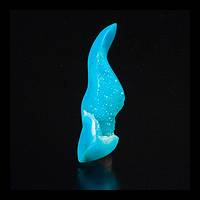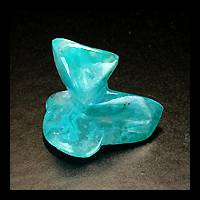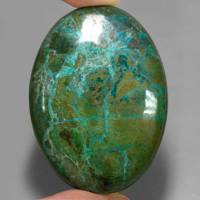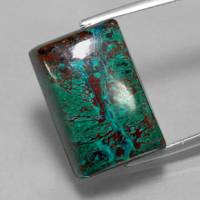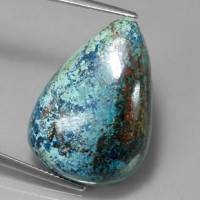Chrysocolla

USA
16.46 carats
© Palagems
Pure chrysocolla is a soft and fragile material. Much of the chrysocolla used in jewellery consists of very attractive cabochons of green or blue chrysocolla impregnating either rock crystal or opal.
Chrysocolla is often found in a matrix of quartz, in which case the optical and physical properties may be closer to those of quartz.
Chrysocolla covered by druses of small sparkling quartz crystals is called "Drusy Chrysocolla" and is very popular for jewelry. It is found in Peru.
The rarest and best quality is chrysocolla chalcedony with turquoise-like colour, but harder and chemically more stable than turquoise. It comes from several copper mines in Arizona, Mexico, Taiwan and Peru.
See also: Eilat Stone, a blue-green gem material from Israel that contains Chrysocolla.
Chrysocolla Gemstones by Colour
This table shows the variety of hues this gemstone can be found in. Click on a photo for more information.
Chrysocolla Gemstones by Size
This table shows distribution of Chrysocolla gemstone sizes that are listed on this site. This can give a good indication as to the general availability of this gemstone in different sizes.
Contributed photos
Lightest:0.42 cts
Heaviest:166.65 cts
Average:31.54 cts
Total photos:50
Do you have a larger Chrysocolla? Why not upload a photo?
| General Information | ||||||||||||||||||||||||||
|---|---|---|---|---|---|---|---|---|---|---|---|---|---|---|---|---|---|---|---|---|---|---|---|---|---|---|
| Other Names/Trade Names: | ||||||||||||||||||||||||||
| Chemical Formula |
| |||||||||||||||||||||||||
| Chrysocolla Treatments | ||||||||||||||||||||||||||
| These copper-containing minerals have blue-to-green color and occur together with other copper minerals, as well as in a disseminated form in chalcedony, opal, and quartz (Webster). Dyeing has been used to enhance the color and to make it resemble turquoise or other gemstones – Nassau (1984) | ||||||||||||||||||||||||||
| Physical Properties of Chrysocolla | ||||||||||||||||||||||||||
| Mohs Hardness | 2 to 4, Blue Chart Gem Identification (2010) More from other references | |||||||||||||||||||||||||
| Specific Gravity | 2.00 to 2.45+, Blue Chart Gem Identification (2010) More from other references | |||||||||||||||||||||||||
| Tenacity | Brittle, Gems, Sixth Edition (2006) | |||||||||||||||||||||||||
| Cleavage Quality | None, Gemstones of the world (2001) | |||||||||||||||||||||||||
| Fracture | Conchoidal, Gemstones (2009) | |||||||||||||||||||||||||
| Optical Properties of Chrysocolla | ||||||||||||||||||||||||||
| Refractive Index | 1.460 to 1.570, Gemstones of the world (2001) More from other references | |||||||||||||||||||||||||
| Optical Character | Biaxial/-, Gemmological Tables (2004) | |||||||||||||||||||||||||
| Birefringence | 0.023 to 0.040, Gemstones of the world (2001) More from other references | |||||||||||||||||||||||||
| Pleochroism | Absent, Gemstones of the world (2001) More from other references | |||||||||||||||||||||||||
| Dispersion | None, Gemstones of the world (2001) | |||||||||||||||||||||||||
| Colour | ||||||||||||||||||||||||||
| Colour (General) | Green to blue veins and patches, Blue Chart Gem Identification (2010) More from other references | |||||||||||||||||||||||||
| Causes of Colour | Blue, Cu2+ in octahedral coordination, Pragmatic Spectroscopy For Gemologists (2011) | |||||||||||||||||||||||||
| Transparency | Opaque, Gemmological Tables (2004) More from other references | |||||||||||||||||||||||||
| Lustre | Vitreous,Waxy, Gemstones (2009) | |||||||||||||||||||||||||
| Fluorescence & other light emissions | ||||||||||||||||||||||||||
| Fluorescence (General) | None, Gemstones of the world (2001) | |||||||||||||||||||||||||
| Crystallography of Chrysocolla | ||||||||||||||||||||||||||
| Crystal System | Monoclinic, Gemstones of the world (2001) More from other references | |||||||||||||||||||||||||
| Habit | Compact grape-like aggregates (botryoidal), Gemstones of the world (2001) More from other references | |||||||||||||||||||||||||
| Geological Environment | ||||||||||||||||||||||||||
| Where found: | Chrysocolla is a mineral of secondary origin occurring in the oxidized zones of copper deposits where it may be mixed with malachite or turquoise, Gems, Sixth Edition (2006) | |||||||||||||||||||||||||
| Inclusions in Chrysocolla | ||||||||||||||||||||||||||
| Common intergrown with chalcedony, malachite and others - Gemmological Tables, Ulrich Henn and Claudio C. Milisenda, 2004, p 12 | ||||||||||||||||||||||||||
| Further Information | ||||||||||||||||||||||||||
| Mineral information: | Chrysocolla information at mindat.org | |||||||||||||||||||||||||
| Significant Gem Localities | ||||||||||||||||||||||||||
| ||||||||||||||||||||||||||













